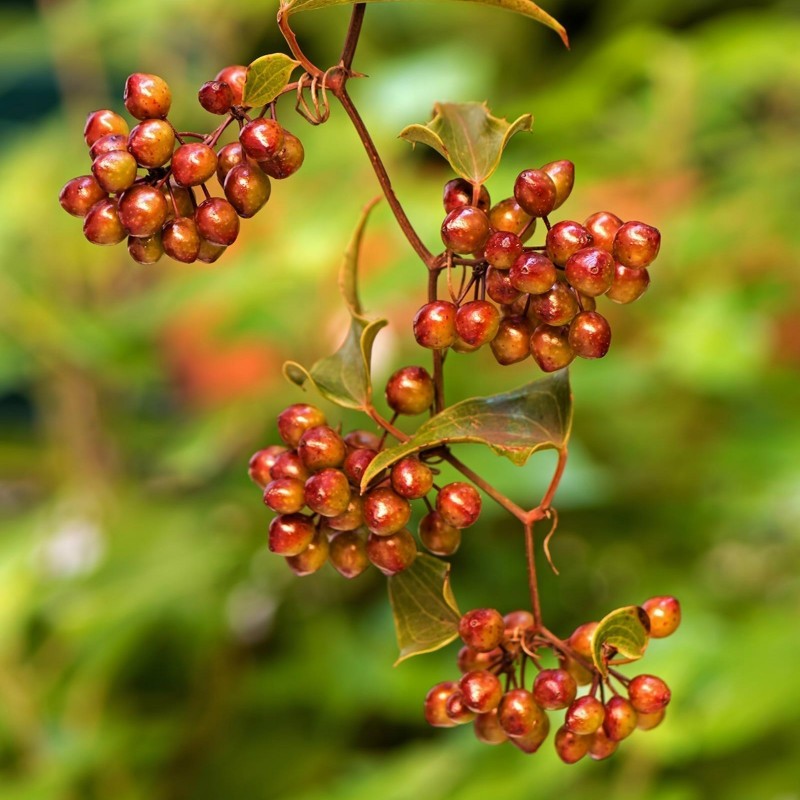
Planta rezistenta la frig si inghet







Smilax aspera, with common names common smilax, rough bindweed, sarsaparille, and Mediterranean smilax, is a species of flowering vine in the greenbriar family. Smilax aspera is a perennial, evergreen climber
Smilax aspera, with common names common smilax, rough bindweed, sarsaparille, and Mediterranean smilax, is a species of flowering vine in the greenbriar family.
Smilax aspera is a perennial, evergreen climber with a flexible and delicate stem, with sharp thorns. The climbing stem is 1–4 metres (3 ft 3 in–13 ft 1 in) long.[5] The leaves are 8–10 centimetres (3.1–3.9 in) long, petiolated, alternate, tough and leathery, heart-shaped, with toothed and spiny margins. Also the midrib of the underside of the leaves are provided with spines. The flowers, very fragrant, are small, yellowish or greenish, gathered in axillary racemes. The flowering period in Mediterranean regions extends from September to November. The fruits are globose berries, gathered in clusters, which ripen in Autumn. They are initially red, later turn black. They have a diameter of 8–10 millimetres (0.31–0.39 in)[5] and contain one to three tiny and round seeds. Insipid are unpalatable to humans and are a source of nourishment for many species of birds.
It is widespread in Central Africa (Democratic Republic of Congo, Kenya, Ethiopia), Mediterranean Europe (Albania, Croatia, Greece, Italy,Malta, France, Portugal, Spain), temperate Asia (Cyprus, Israel, Jordan, Lebanon, Syria, Turkey) and tropical Asia (India, Bhutan, Nepal). It is also naturalized in other regions.
It grows in the woods and scrubs, at an altitude of 0–1,200 metres (0–3,937 ft) above sea level.
Edible Parts: Leaves; Root.
Edible Uses: Drink.
Young shoots - raw or cooked as a vegetable. They can be cooked and used as an asparagus substitute. The tendrils are also eaten. The plant is an ingredient of soft drinks. (this probably refers to the root)
Plants For A Future can not take any responsibility for any adverse effects from the use of plants. Always seek advice from a professional before using a plant medicinally.
Alterative; Antipsoriatic, Demulcent, Depurative, Diaphoretic, Diuretic, Parasiticide, Stimulant,
Tonic.
The root is alterative, demulcent, depurative, diaphoretic, diuretic, stimulant and tonic.
This is one of the best depurative medicines and is used as a springtime tonic and general body cleanser, usually with woody nightshade (Solanum dulcamara). The root has all the medicinal virtues of the widely used tropical herb sarsaparilla, though to a lesser degree. It is often used as an adulterant to that plant. The ripe fruits are squeezed and applied to the skin in the treatment of scabies.
Dye, Hedge, Hedge, Parasiticide.
A red dye is obtained from the ripe tendrils[148]. The plant is often grown as an impenetrable hedge in warmer countries than Britain.
Succeeds in most soils in sun or semi-shade[200]. A very ornamental plant, it is only hardy in the mildest areas of Britain, tolerating temperatures down to about -10°c. The flowers have a heavy sweet perfume. Dioecious. Male and female plants must be grown if seed is required.
Seed - sow March in a warm greenhouse. This note probably refers to the tropical members of the genus, seeds of plants from cooler areas seem to require a period of cold stratification, some species taking 2 or more years to germinate. We sow the seed of temperate species in a cold frame as soon as we receive it, and would sow the seed as soon as it is ripe if we could obtain it then. When the seedlings eventually germinate, prick them out into individual pots when they are large enough to handle and grow them on in the greenhouse for at least their first year, though we normally grow them on in pots for 2 years. Plant them out into their permanent positions in early summer. Division in early spring as new growth begins. Larger divisions can be planted out direct into their permanent positions. We have found it best to pot up the smaller divisions and grow them on in a lightly shaded position in a cold frame, planting them out once they are well established in the summer. Cuttings of half-ripe shoots, July in a frame.
Right plant wrong place. We are currently updating this section. Please note that a plant may be invasive in one area but may not in your area so it’s worth checking.
Fisa tehnica

 Reviews (0)
Reviews (0)